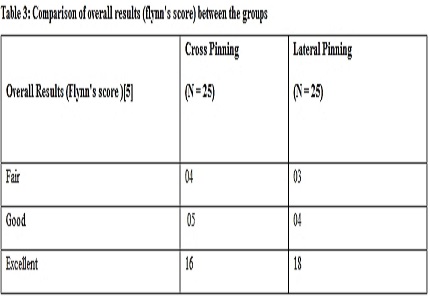Operative management of paediatric Supracondylar fractures of Humerus Extension type: The Results of K-wire Placement
Abstract
Aim: To study the k wire placement Cross Pinning Versus Lateral Pinning technique, in terms of functional outcome and complications in the operative management of paediatric supracondylar fractures of humerus extension type.
Methodology: A total of 50 patients of supracondylar humerus fracture extension type-III were included in the study. 25 patients were operated by closed reduction with Cross K pinning fixation and 25 patients were operated by closed reduction and Lateral 2 K pinning fixation. All patients were followed up to 9 months and assessed for functional outcome and complications.
Results: The two groups were comparable with respect to age /sex/weight/height and type of fractures. All patients of crosspinning were inmobilized for three weeks whereas in lateral pining 9% patients were immobilized for 4 weeks. The two groups were compared with respect to time till union, range of movement (ROM), carrying angle and function which was done at 3,6 and 9 months. 8.33% of the patients of cross pining group had ulnar nerve injury. 66.7% had excellent results in cross pinning compared to 70.6% in lateral pinning.
Conclusion: There is no significant difference in the stability provided by the cross pinning and two lateral pin fixation method. But the medial and lateral pin fixation group shows two cases of iatrogenic ulnar nerve injury. Therefore, lateral pin fixation method for the treatment of type III supra condylar fracture requiring surgery is a reliable and safe method to avoid iatrogenic ulnar nerve injury and provides adequate stability if proper pin fixation principles are used.
Downloads
References
2. Mahan ST, May CD, Kocher MS. Operative management of displaced flexion supracondylar humerus fractures in children. Journal of Pediatric Orthopaedics. 2007 Jul 1;27(5):551-6. [PubMed]
3. Topping RE, Blanco JS, Davis TJ. Clinical evaluation of crossed-pin versus lateral-pin fixation in displaced supracondylar humerus fractures. Journal of Pediatric Orthopaedics. 1995 Jul 1;15(4):435. [PubMed]
4. Rowell PJ. Arterial occlusion in juvenile humeral supracondylar fracture. Injury. 1975 Feb;6(3):254-6. [PubMed]
5. FLYNN JC, MATTHEWS JG, BENOIT RL. Blind pinning of displaced supracondylar fractures of the humerus in children. J Bone Joint Surg Am. 1974 Mar 1;56(2):263-72.
6. Barton KL, Kaminsky CK, Green DW, Shean CJ, Kautz SM, Skaggs DL. Reliability of a modified Gartland classification of supracondylar humerus fractures. J Pediatr Orthop. 2001 Jan-Feb;21(1):27-30. [PubMed]
7. Zionts LE, McKellop HA, Hathaway R. Torsional strength of pin configurations used to fix supracondylar fractures of the humerus in children. J Bone Joint Surg Am. 1994 Feb;76(2):253-6. [PubMed]
8. Lyons JP, Ashley E, Hoffer MM. Ulnar nerve palsies after percutaneous cross-pinning of supracondylar fractures in children's elbows. Journal of Pediatric Orthopaedics. 1998 Jan 1;18(1):43-5.
9. Wind WM, Schwend RM, Armstrong DG. Predicting ulnar nerve location in pinning of supracondylar humerus fractures. J Pediatr Orthop. 2002 Jul-Aug;22(4):444-7. [PubMed]
10. Leitch KK, Kay RM, Femino JD, Tolo VT, Storer SK, Skaggs DL. Treatment of multidirectionally unstable supracondylar humeral fractures in children. J Bone Joint Surg Am. 2006 May 1;88(5):980-5. [PubMed]
11. Brauer CA, Lee BM, Bae DS, Waters PM, Kocher MS. A systematic review of medial and lateral entry pinning versus lateral entry pinning for supracondylar fractures of the humerus. J Pediatr Orthop. 2007 Mar;27(2):181-6. [PubMed]
12. Ramachandran M, Birch R, Eastwood DM. Clinical outcome of nerve injuries associated with supracondylar fractures of the humerus in children THE EXPERIENCE OF A SPECIALIST REFERRAL CENTRE. Journal of Bone & Joint Surgery, British Volume. 2006 Jan 1;88(1):90-4. [PubMed]
13. Omid R, Choi PD, Skaggs DL. Supracondylar humeral fractures in children. J Bone Joint Surg Am. 2008 May;90(5):1121-32. doi: 10.2106/JBJS.G.01354. [PubMed]
14. Rasool MN. Ulnar nerve injury after K-wire fixation of supracondylar humerus fractures in children. J Pediatr Orthop. 1998 Sep-Oct;18(5):686-90. [PubMed]
15. Cheng JC, Lam TP, Maffulli N. Epidemiological features of supracondylar fractures of the humerus in Chinese children. J Pediatr Orthop B. 2001 Jan;10(1):63-7. [PubMed]
16. Farnsworth CL, Silva PD, Mubarak SJ. Etiology of supracondylar humerus fractures. J Pediatr Orthop. 1998 Jan-Feb;18(1):38-42. [PubMed]
17. Houshian S, Mehdi B, Larsen MS. The epidemiology of elbow fracture in children: analysis of 355 fractures, with special reference to supracondylar humerus fractures. J Orthop Sci. 2001;6(4):312-5. [PubMed]
18. Rowell PJ. Arterial occlusion in juvenile humeral supracondylar fracture. Injury. 1975 Feb;6(3):254-6. [PubMed]
19. Rockwood CA. Rockwood and Wilkins' fractures in children. Beaty JH, Kasser JR, editors. Lippincott Williams & Wilkins; 2010. [PubMed]
20. McKee MD, Kim J, Kebaish K, Stephen DJ, Kreder HJ, Schemitsch EH. Functional outcome after open supracondylar fractures of the humerus. The effect of the surgical approach. J Bone Joint Surg Br. 2000 Jul;82(5):646-51. [PubMed]
21. Mehserle WL, Meehan PL. Treatment of the displaced supracondylar fracture of the humerus (type III) with closed reduction and percutaneous cross-pin fixation. J Pediatr Orthop. 1991 Nov-Dec;11(6):705-11.
22. Brown IC, Zinar DM. Traumatic and iatrogenic neurological complications after supracondylar humerus fractures in children. Journal of Pediatric Orthopaedics. 1995 Jul 1;15(4):440-3. [PubMed]
23. Sahu RL. Percutaneous K-wire fixation in paediatric Supracondylar fractures of humerus: A retrospective study. Nigerian medical journal: journal of the Nigeria Medical Association. 2013 Sep;54(5):329. [PubMed]
24. Webb AJ, Sherman FC. Supracondylar fractures of the humerus in children.J Pediatr Orthop. 1989 May-Jun;9(3):315-25. [PubMed]
25. Kocher MS, Kasser JR, Waters PM, Bae D, Snyder BD, Hresko MT, Hedequist D, Karlin L, Kim YJ, Murray MM, Millis MB, Emans JB, Dichtel L, Matheney T, Lee BM. Lateral entry compared with medial and lateral entry pin fixation for completely displaced supracondylar humeral fractures in children. A randomized clinical trial. J Bone Joint Surg Am. 2007 Apr;89(4):706-12.



 OAI - Open Archives Initiative
OAI - Open Archives Initiative


